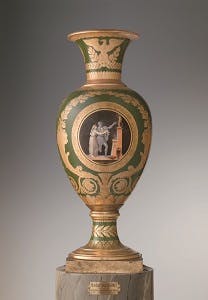Oval vase
Sèvres Factory
“XX.MARS.MDCCCXI”; “Coupin End. fecit”
As indicated by the inscription under the central decoration, this 'third size' oval-shaped vase without handles belongs to Napoleon's gifts to Ferdinand III Habsburg-Lorraine for his role as godfather at the baptism of the Emperor's son in 1811 in the Cathédrale Notre-Dame de Paris. On this occasion he also received other porcelain made in the Sèvres Factory from Napoleon, which he brought to the Pitti Palace in 1814 when he returned from exile (inv. A.c.e. 1911, nos. 492-493, 212; inv. A.G. 1890, no. 8749; inv. O.d.A. 1911, nos. 158, 486).
These tributes all share the underlying theme of celebrating Napoleon's magnificence, which is present on each piece. In this case they are identifiable in the rich gold decoration with the imperial symbol of the eagle with spread wings and the military trophies inscribed in a medallion on the back of the vase. Inserted in a circular frame surrounded by whirls and cornucopias from which locks of laurel emerge, on the front side there is a polychrome depiction of the Allegory of Hymen, as described in the inventories of the Sèvres factory, although in connection with the aforementioned baptism it has been interpreted as a representation of Napoleon and his wife Marie-Louise Habsburg-Lorraine. Dressed in the old-fashioned way, as a Roman emperor and his wife, they were portrayed showing their son to the god Mars depicted with a statue placed on a column with a votive altar in front, where the sacred fire burns. The author of the decoration is Marie-Philippe Coupin de La Couperie, as revealed by the signature on the vase. He was a pupil of Anne-Louis Girodet de Roussy, known as Girodet-Trison, and he specialised in grisaille painting in imitation of ancient cameos. From 1804 to 1812, he was active at the factory as an external collaborator and in 1809 he drew up the design for the main scene of our specimen, which was originally designed to have a gilded bronze decoration executed by Pierre Philippe Thomire, but possibly never mounted.
